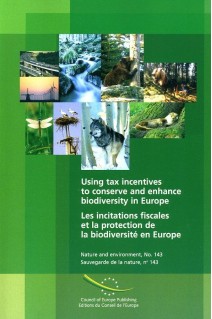



This report looks at ways in which tax incentives may help to promote conservation of biological and landscape diversity in Europe.It outlines how tax incentives relate to other conservation policy options (Part I) before describing existing measures in and beyond Europe that directly benefit landholders (Part II) or create an enabling climate for the conservation sector (Part III). Part IV provides some indicators for the design of tax measures. Part V sets out conclusions and provides draft elements for a future recommendation to Council of Europe Member States on the development of fiscal incentive policies to support measures for biodiversity protection.
Introduction: objectives and methodology
I. Overview of conservation policy options
A. Regulatory measures
B. Non-regulatory measures: the growth of incentives C. Where do tax incentives fit in?
II. Tax incentives that directly support landholders
A. Real property taxes
1. Property transfer taxes (registration fees and stamp duty).
2. Local land taxes (rates)
a. Differential rates for conservation
b. Revenue implications for local authorities
B. Personal and general taxes
1. Income tax
a. Relief linked to land management practices
b. Reliefs on donation of property interests (conservation easements
2. Wealth tax
3. Value added tax on conservation-related expenditure.
4. Capital gains tax
5. Inheritance tax (death duties)
6. Intestacy
III. Tax frameworks that support the conservation sector.
A. Tax status of private conservation organisations
B. Incentives for donations
C. Initiatives to simplify giving .
1. Guidance and information.
2. Administrative procedures
3. Transnational donations
D. Earmarking tax revenues for conservation
E. Tax relief on environmentally friendly investment
IV. Practical indicators for designing tax incentives
A. Objectives
B. Quality assurance mechanisms
1. Criteria for selection
2. Valuation of donated land
3. Organisations eligible to receive donations
4. Sanctions and safeguards
V. Conclusion and recommendations
A. Current constraints on biodiversity-friendly tax policy.
B. Opportunities identified
C. Recommendations
Appendix : Questionnaire circulated to Contracting Parties.

This report looks at ways in which tax incentives may help to promote conservation of biological and landscape diversity in Europe.It outlines how tax incentives relate to other conservation policy options (Part I) before describing existing measures in and beyond Europe that directly benefit landholders (Part II) or create an enabling climate for the conservation sector (Part III). Part IV provides some indicators for the design of tax measures. Part V sets out conclusions and provides draft elements for a future recommendation to Council of Europe Member States on the development of fiscal incentive policies to support measures for biodiversity protection.
Please note that in accordance with our terms & conditions, PDF/epubs may only be purchased by private individuals.
